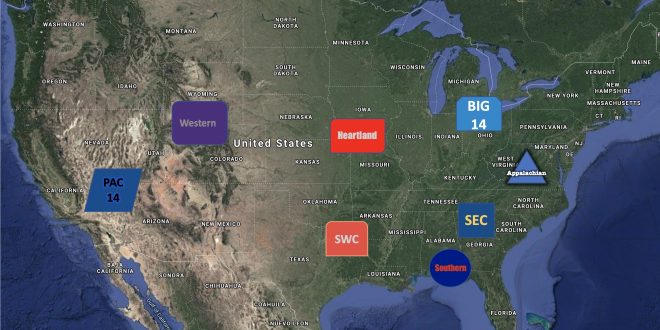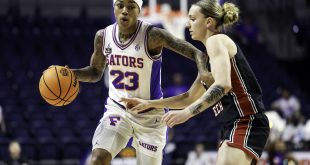How many different ways has it been said that this year has been a dumpster fire? For college athletics, the chaos of 2020 has unearthed deep cracks in a system of dysfunctional leadership divided by geography, politics, and mixed messaging.
A single multi-billion dollar business in which a multitude of conferences fights for power over their single most profitable product. Each conference and institution markets this product as a single sports association in which everyone across the nation can connect with. Through these efforts, each conference tries to shape this product into their own image. If you haven’t realized it by now this product is college football. The only way to mend the cracks and organize the dysfunction is under centralized leadership. A centralized governing body is a great way to keep conferences and institutions on the same page during a crisis. They could also help to structure the sport in a way that would fix many of the other issues college football faced prior to the pandemic.
College Football’s conferences have gone haywire. Without a centralized governing body, conferences compete for lucrative TV markets, potential new member institutions, and playoff spots. This has been to the detriment of the on-field product fans want to see long before 2020. This divide has ramifications far beyond the individual decisions made in the last few months. Previous to 2020 this divide was most apparent in how conferences aligned themselves. We are going to take a moment here to wave a magic wand and imagine a new governing body for college athletics. One that kicks the NCAA to the curb and offers a new centralized set of competitive parameters.
This Centralized Governing Body
- Has the power to reassign universities to athletic conferences as it sees fit.
- Has the power to move and stratify sports programs between the four levels of intercollegiate athletics (FBS, FCS, Division 2, Division 3)
- Understands the necessity of giving institutions the opportunity to move up or down based on the fiscal health, size, and success of their athletic department.
- Regulates the scheduling of teams across divisions (FBS, FCS, etc.).
What is currently wrong with FBS Competition?
Now let’s focus on the FBS (the money maker – this level of college football is a multi-billion dollar industry). We first need to understand what issues have been created by mismanagement within the current system.
Competitive imbalance
By allowing FBS teams to play FCS teams whenever they want, the institutions are watering down their product. If Alabama wants to play a lesser team there are a lot of options they have to pass up before Tennessee-Chattanooga takes the field. They’ve played the Chattanooga Mocs thirteen times including in 2009, 2013, and 2016. Do anyone outside of Alabama and the city of Chattanooga remember those games?
Loss of key rivalry games
Nothing has helped College football to become the money maker it is today quite like rivalry games. Ohio State vs. Michigan, Texas vs. Texas A&M, Notre Dame vs. USC, Oklahoma vs. Nebraska, etc. These are the types of games who’s intensity and national implications have helped to build the college football landscape that fans have become accustomed to.
Loss of perspective in conference additions
TV ratings in collegiate athletics have consistently declined outside of the marque games. Conferences have lost total understanding that geography matters, that competition matters, and that past history between teams matters. Iowa Hawkeye fans love football. They just don’t care to watch Iowa play Rutgers, and care much less about traveling to NJ. The result was 545,000 viewers tuning in to watch Iowa vs. Rutgers ( a cross-divisional BIG 10 matchup) 162K less than the number of viewers tuning in to watch Iowa vs. Miami (OH) the week before. In the same week as Iowa vs. Rutgers, three million people watched Ohio State vs. Cincinnati, 4.72M watched Army vs. Michigan, and 3.45 Million watched Nebraska vs. Colorado. The viewership for Iowa’s game against Wisconsin was a much more acceptable 2.32 million.
Who are the Big Dogs?
Based off of yearly revenue (which we can only find for public institutions), super conferences would include Texas, Texas A&M, Oklahoma, Ohio State, Michigan, Michigan State, Penn State, Wisconsin, Nebraska, Alabama, LSU, Tennessee, Auburn, Georgia, Florida, and Florida State. Year after year the order may change but the composition of that list will largely remain the same. Throwing in another heavy-hitter (Clemson) along with private institutions USC, Notre Dame, and Stanford gives you two super-conferences of ten teams.
Play Only With The Big Dogs?
For college football to stay relevant nationally it needs healthy, successful, and sustainable conferences. But how many conferences, should there be at the highest level of college football? Would having one or two super conferences with the greatest teams from around the country be the best thing for college football? If the largest and most successful institutions formed a conference, how successful would it be?
So what if these top tier teams told the rest of college football to kiss off? You would initially see a large increase in attendance and national attention for the first few years or even the first decade. Over time a few teams will become the top dogs and the rest will start to lose the essence of what made them the incredibly successful programs they had become. Teams who do not win as much will have a drop off in attendance for some of the non-rivalry games. What was once considered monster match-ups lose their luster, and all of college football suffers as a result.
This scenario does not consider the importance of rivalry games in college athletics. Or the potential for individual programs to rise and fall. Therefore we need to keep a larger number of universities and conferences which enables teams to play an exciting and competitive schedule that draws interest from every corner of the country. More conferences and more teams also mean more opportunities for the growth of programs on the rise.
What Makes A Conference Great?
A great conference creates a competitive balance amongst universities with a similar athletic drive and potential. Let’s take the SEC for example. Whether or not you believe it’s the best conference in the land, you can’t argue with the success it has had on the gridiron and in monetizing that success. This is because 13 of the league’s 14 member institutions have committed to maximizing the success of their football programs. That fourteenth team? It’s one with a distant history of success, in a destination market, with potential for growth if it only had the motivation to realize its potential. But enough about Vanderbilt.
This realignment would create conferences that:
- Increase TV revenue and in-game attendance by putting the best product possible on the field and your TV
- Minimize the number of out of conference rivalries played annually to create more flexibility in OOC scheduling
- Have more geographical congruency
- Create consistency across conference schedules
What We Have vs. What We Are Creating
The FBS currently has 130 programs spread across ten conferences, and six independents. Each conference has between ten and fourteen members. With teams playing eight or nine conference games. Member institutions are also held to different standards when scheduling out of conference games.
You will find below 115 teams divided into eight conferences. Each conference consisting of fourteen members. Every team playing eight conference games. All holding its members to only scheduling FBS teams. This leaves three programs that have earned the right to be independent programs through their commitment to serving our country and fighting for our freedom. Instead, they are required to play a round-robin each year for the Commander-in-Chief’s Trophy. Additional programs can join the FBS as independents, but only for a limited time. After twenty years they must either join a conference or move back down to the FCS level.
SEC | SWC | Heartland | BIG 14 | PAC 14 | Appalachian | Western | Southern | The Military Academy Independents | The Twenty Year Independents | Relegated
Conference Scheduling
Three of the eight conferences created will utilize divisional scheduling. This allows each institution to play every team in their conference in a four-year span.
Traditional divisions would make it impossible to play all of the rivalry games in many of the new conferences. This problem leads to the idea of rotational games. Each team plays three permanent rivals on an annual basis, and play the other 10 teams on a rotating basis. Giving every institution the opportunity to play both home and away against every team in the conference within a four-year span. The two teams with the best records would then advance to the conference championship game. The permanent rivals listed for each team are also depicted on a map for each of the five conferences that will utilize this system.
Getting Down to Business
What would the finances look like in this new landscape of college football? With fewer home games and a greater number of high profile match-ups, college football would be choosing to lean further into the current trend of becoming more reliant on television revenue and less reliant on ticket sales. Television rights for playoff games, bowl games, and the national championship are negotiated by the centralized governing body. The resulting revenues are distributed equally to each institution in the FBS. Individual conferences would hold the TV rights to their member institutions’ regular-season schedules. All member institutions must receive an equal distribution of all revenues distributed by their conference.
This does not affect revenues generated by individual institutions. Ticket sales, fundraising, or money an institution earns playing in a bowl game still belong solely to that institution.
Sports other than Football
Conference Realignment is based on football (because that’s where the money is), and that’s mostly what this article is about. However, conference realignment affects all sports. Within the discussion about each conference is a note of some other sports who will feel the effects of realignment. As it currently stands and would continue under this system, it is up to the conferences to decide which sports they will sponsor. Teams in sports not sponsored by the conference their university is a member of are eligible to affiliate with another conference for said sport. I.E. Florida (an SEC institution) playing in the American Athletic Conference for women’s lacrosse.
Now without further ado, here is the ideal conference alignment.
The Southeastern Conference

Changes to Note (From SEC)
Revenue Potential
The SEC currently distributes more than forty million dollars to each of its member institutions each year. Forty million dollars per institution in a conference that regularly schedules FCS opponents and gets those games onto TV. The ACC, where four of the new SEC teams currently reside, distributes less than thirty million to each of its members each season. The new iteration of the SEC will be selling the prospect of a larger number of high profile games. It will have a far improved non-conference schedule. As well as larger markets within their conference footprint which will no longer be shared with the ACC or the AAC. These advantages will increase the SEC’s negotiating power for larger TV contracts that will further increase each team’s cut.
No LSU
This is a huge loss not simply because they are a highly successful program with an incredibly loyal fanbase. LSU was one of the original members of the SEC and will be losing annual match-ups with Auburn and Florida. Granted LSU has been lobbying to get rid of their match-up with Florida for about thirty years, and Auburn hasn’t won at Death Valley during this millennium. LSU will be keeping their annual showdown with Alabama, and still vastly improve the rest of their out-of-conference schedule.
Clemson
Trading out one death valley for another, Clemson is an ideal fit for the SEC. There is already a high level of familiarity resulting from Clemson’s annual rivalry with South Carolina, their proximity to Georgia, and their history both on and off the field with Alabama. While the rest of the nation will just be happy to have Alabama vs. Clemson settled before the playoffs start, Clemson will significantly bulk up its regular-season schedule. This is something Clemson has been trying to do through its nonconference schedule for years with home and home match-ups against the likes of Auburn, Texas A&M, Georgia, and LSU. Clemson has outgrown the ACC, as not one institution north of Clemson has won a national title as a member of the ACC. In fact, the only national titles in football out of the ACC have come from FSU, Georgia Tech, and Clemson (Titles claimed by other ACC institutions were prior to joining the conference).
Florida State
A university with three national titles located closer to Auburn and UF than any of its ACC competition. Sounds like they should have been in the SEC thirty years ago. FSU has flirted with joining the SEC before. This move was blocked multiple times by UF and once by the legendary Bobby Bowden. Interestingly, they have already played Florida, South Carolina, and Auburn more times than they have played the likes of Duke, Virginia, Boston College, and Syracuse. FSU also keeps its rivalries with Miami, Florida, and Clemson as annual opponents.
Miami
Five national titles. Zero positive takes from the ACC. Miami should be happier to leave the ACC than they were to leave the Big East. A move that signified the end of Miami football as a powerhouse in college football. Hopefully, a better slate of games will re-energize fans and the added revenue will give Miami the resources it needs to pull itself out of the darkest pits of an otherwise respectable program history. Miami will also have a multitude of in-state rivals in this newly minted version of the SEC.
Georgia Tech
The prodigal son returns. Is it too soon to say Georgia Tech never should have left the SEC? We aren’t expecting them to start beating anyone 222 – 0 but don’t expect them to become the new Arkansas or Vanderbilt of the SEC either. A historic program in college football’s capital city deserves to compete with the best. Renewed rivalries with Auburn and Alabama will be balanced by continued competition with fellow additions from the ACC.
UCF
The Knights earned the right to play with the big boys after their national championship run in 2017. Just kidding. They didn’t win a title in 2017, and that’s not how realignment works. They are added to the SEC because of a growing fanbase willing to risk their lives filling a structurally unsound stadium. Which is affectionally referred to as the bounce house. Also, their athletic department ranks in the top sixty in revenue, and they are located in the largest TV market void of professional football.
USF
UCF does bring in a better resume on the field. However, USF brings just as strong of a resume off of the field. An institution in a large market, on fertile recruiting ground, and in a vacation destination (great for visiting teams). USF makes a great addition to round out the new Southeastern conference.
Vanderbilt
I flirted with adding Louisville and taking out Vanderbilt. However, Nashville is the kind of destination that belongs in the SEC. The decision actually has just as much to do with Louisville being a better fit for a basketball-centered conference. That being said, I really do believe that with the proper guidance Vanderbilt could field a far more competitive unit.
SEC Permanent Rivals Mapped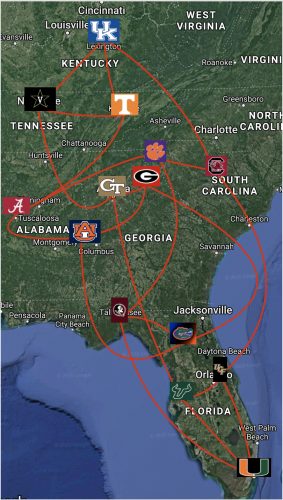
Conference Rotation for the SEC
The SEC in Other Sports
Men’s Basketball
Kentucky is still the premier basketball program in this league. That being said, the competition has been getting stiffer in the SEC and the addition of FSU and Georgia Tech will only further the rise of basketball in this conference.
Baseball
Losing Ole Miss and Mississippi State will be felt most in baseball. They both have great followings and are the best rivalry in college baseball. Losing LSU baseball also means watching a program with six national titles walk out the door. The good news is that each of the additions from the ACC are proven programs that can hold their own on the diamond.
Women’s Gymnastics
The SEC as currently constructed has been the best Gymnastics conference in the country top to bottom. Georgia, Florida, and Alabama have combined to claim nineteen NCAA team championships since 1987. LSU has come frustratingly close to a national title on multiple occasions, and their gymnastics team will be sorely missed in the new iteration of this conference. The new iteration of the SEC leaves Georgia, Florida, and Alabama together to sharpen their skills in conference play. Before facing the fellow powerhouse programs of UCLA and Oklahoma.
The Southwestern Conference

Changes to Note (From Big 12)
Revenue Potential
The Big 12 distributes between thirty-three and thirty-seven million dollars a year to its institutions. It is the only power five conference without a conference network and the only one which doesn’t distribute its revenue equally amongst its institutions. The Big 12 allows itself to be bullied by the Texas Longhorns in allowing them to operate their own network (The Longhorn Network) and in unevenly distributing the revenue to benefit the conference’s largest institutions to the detriment of the conference as a whole. In the new iteration of the SWC, the conference will own the rights to its teams’ regular-season games. The new SWC will also consist of some major heavyweights which will mitigate the influence Texas has on the overall outlook of the conference.
LSU
Without Ole Miss, Texas A&M, and Arkansas in the SEC, the only reason for LSU to stay in the SEC would be Alabama. LSU and Alabama would still play every year, but the stakes would only have national title and not conference title implications. In the Southwestern Conference LSU will play the likes of Texas, Baylor, TCU, and Texas Tech. As well as hold on to its traditional rivalry games. Their new conference is also more suited for traveling LSU fans as Texas, Texas A&M, UTSA and Houston are all an easy jaunt down I-10. More than likely the conference title in this league would come down to a battle between the winner of the LSU and Texas A&M game against Texas, which would draw great ratings either way.
Ole Miss
Where LSU and Mississippi State go, so does Ole Miss. Ole Miss will keep its top three rivals by playing Vanderbilt every year out-of-conference and going West with Mississippi State and LSU. They also pick-up an annual conference game against Memphis which has always been a consistent rival of Ole Miss.
Memphis
A solid addition from the AAC. Memphis is more than a good enough program to keep up with the likes of Ole Miss, Arkansas, and Mississippi State. They will probably have a real problem with LSU and Texas A&M, but few programs wouldn’t. Memphis will make their rivalry with Ole Miss an annual affair, and keep Houston as an in-conference opponent.
Arkansas
This move is not about Arkansas never being a fit for the SEC. They are just a way better fit where they’re headed. Arkansas, who came into the SEC with South Carolina in 1990 was a great addition at the time. This is a program that had preexisting rivalries with Ole Miss and LSU. As well as a fervent fanbase that desperately wants to win. In this new conference, Arkansas gets to keep annual matchups with Ole Miss, Texas A&M, and LSU in addition to rekindling rivalries with former SWC opponents in cross-divisional matchups.
Mississippi State
Alabama’s little brother is flying the coop. MSU has had some heated games with the far more successful institution located just 85 miles down Highway 82. But the wins have been few and far between. In the 103 match-ups between the two programs, Mississippi State has claimed only 18 wins. They have been winless in the series since 2007. Mississippi State has had better luck against the likes of Ole Miss, Arkansas, Texas A&M, and Memphis who will all be annual opponents in their new conference.
Texas A&M
A conference that allows Texas A&M to keep an annual game with LSU and play its former Big 12 rivals on a rotational basis. Sign me up! With how heated the Texas / Texas A&M rivalry has been in the past, playing every four years and/or in the conference title game will be the perfect set-up.
Houston
Located in a large metropolitan area in Texas, and only a couple hours from LSU and Texas A&M. Houston may not currently be a powerhouse program, but they round out the division nicely. This program has a lot of room to improve based on the fact that they are a large public university in a major market. They also happen to be surrounded by some of the most fertile recruiting ground in the country.
Texas
Won’t be able to hold TV contracts hostage in this new league, but should be able to dominate the West division of the SWC unless Baylor/Texas Tech/TCU have anything to say about it. They also will have regular matchups with Texas A&M, LSU, Arkansas, etc. which will beef up their schedule in addition to their rivalry with Oklahoma out-of-conference.
Southwestern Conference Divisions Mapped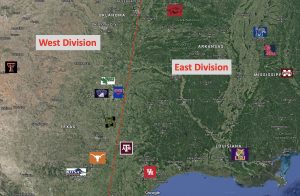
Conference Rotation for the SWC
The SWC in Other Sports
Baseball
The SWC gets the best rivalry in college baseball in the Magnolia state, reignites the Texas vs. Texas A&M rivalry, and adds LSU who will continue making routine trips to Omaha.
Men’s Golf
Houston, LSU, Texas, and North Texas combine to have won 28 National Titles in Golf. That’s not including Texas A&M who won the natty in 2009. If there’s any conference you might want to hit the links with, it’ll be this one.
The Heartland Conference

Standouts
Revenue Potential
The Heartland conference has within its footprint the TV markets of Denver, Oklahoma City, Minneapolis, Kansas City, State. Louis, and Chicago. Each is a huge market for football, which would enjoy some major college football that is centralized to and celebrates the Heartland of the U.S. By launching their own network, the Heartland conference can take advantage of the markets. Generating revenue at a rate that those joining from the Big 12 haven’t experienced and those from the Big 10 West are used to.
Oklahoma
Keeps its rivalry with Texas out-of-conference. They also renew their rivalry with Nebraska along with other former Big 8 rivals. In addition to adding games against the best of the former Big 10 West. The only downside is having to drag along their little brother (Oklahoma State).
Nebraska
The band is back together. Time to beat up on the lesser competition, play one big game against Oklahoma, and rock the college football world like it’s 1995. No more getting bullied by Texas or getting slobberknockered by Michigan, Penn State, Ohio State, Purdue, etc. Except you’ll still have to face the likes of Wisconsin and Iowa. Who you’ve gone a combined 4 and 14 against since joining the Big 10. All that being said, Nebraska is still one of the biggest names in college football. So Nebraska fans can still hope for a resurgence under Coach Scott Frost. Or whoever they hire next after getting overly impatient with him.
Missouri
For an institution that never really fit in with the SEC, the growth Missouri has shown in its athletic department during its time with the conference is astounding. That being said, Missouri has no rivals and little history with any of the teams in the SEC. They should however be primed to continue their growth playing teams from the heartland. In the Heartland, they can continue their rivalry with Kansas. O, and they now also have the capacity to take on the likes of their former Big 8 foes. Without reverting back to welcome mat status for Nebraska and Oklahoma, Missouri will help to grow the reputation of the Heartland Conference nationally.
Colorado
Has never made sense in the PAC 12. They also didn’t fit in with the Texas teams of the Big 12. Colorado should be ecstatic with its move to the Heartland. Loving everything about it except that they are the only team that will have to face both Nebraska and Oklahoma on an annual basis.
Iowa
As a longtime member of the Big 10, it is weird to see Iowa in a conference with members of the Big 8. I can’t argue that, but with many of their fellow West division rivals moving on from the Big 10, they should have greater opportunities to play for and win conference titles.
Northwestern
From a TV Market standpoint, this is a big loss for the Big 10. Along with Minnesota and Wisconsin, the Heartland Conference will be picking up some major markets in Chicago, Minneapolis, and Milwaukee. Northwestern gets to keep its biggest rivals (Illinois as an annual OOC rival) and will be the single best destination for traveling fans in the conference.
Wisconsin
From a competitive standpoint, Wisconsin is the best addition from the Big 10. They should be able to hold their own against Oklahoma and compete for conference and playoff appearances here. It is interesting to wonder how Wisconsin’s slower and more physical style of play matches up against Oklahoma, Missouri, and Iowa State.
Heartland Conference Permanent Rivals Mapped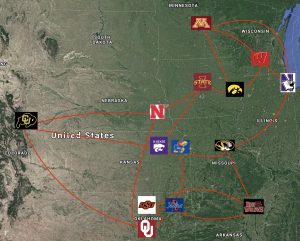
Heartland Conference Rotation
The Heartland in Other Sports
Basketball
Missouri rejoins the best basketball programs from the Big 12 and gets to reignite its rivalry with Kansas on the hardwood. The physical play of the additions from the Big 10 West will also have an interesting effect on conference play.
Wrestling
The Big 12 and the Big 10 clearly have the best wrestling in the country. The Heartland Conference will have the best competition top to bottom by adding Iowa and Minnesota to an already impressive line-up from the former Big 8. However, I don’t think Iowa and Minnesota will miss having to face Penn State and Ohio State in conference matches. What will be fun to see is two historic powerhouses and in-state rivals square off as conference opponents when Iowa and Iowa State hit the mats.
The Big 14 Conference

Changes to Note (From Big 10)
Revenue Potential
The Big 14 takes the powerhouses of the Big 10 who currently distributes approximately fifty-four million dollars to each of its institutions and adds another national brand in Notre Dame. The additions of Virginia Tech, West Virginia, and Pittsburgh also expand the conference east, into populated football-loving states. Expanding in a way that feels natural, and much different than the addition of Rutgers did to the Big 10.
Notre Dame
Doesn’t belong in the ACC! What part of Northwest Indiana makes you think, “Atlantic Coast?” Notre Dame is an ideal fit for the BIG 14. They keep playing their cross-country rival USC on an annual basis. Yet still have a lot of room to work with regarding their out-of-conference schedule. Seeing Notre Dame versus Ohio State, Michigan, Penn State, etc. on a regular basis is not only exciting but it also just feels right.
Penn State
Since joining the Big 10, Penn State has had some incredible games against Ohio State, Michigan State, and the rest of the league. In this new iteration of the Big 10 (more logically called the Big 14) Penn State will still play regularly against the top dogs of the former conference. They also add in historic rivalries against Pitt and West Virginia.
Pittsburgh
Never made sense in the ACC to me when their biggest rivalries have always been against Penn State, Notre Dame, and West Virginia. This conference has all of them, and will significantly boost the annual revenue they receive from their conference.
Virginia Tech
Yes, they were a great fit in the ACC. A conference that has fallen well behind other Power 5 conferences in terms of its level of competition and competitive balance. Virginia Tech will be in a better financial position in the Big 14 and keep its annual rivalry with Virginia (as well as rekindle its rivalry with West Virginia).
West Virginia
This is obvious. West Virginia gets Pitt, Penn State, and Virginia Tech annually. They also get games against Ohio State, Maryland, Notre Dame, and Virginia, all of which are much more natural conference opponents than any of the Big 12 institutions.
Cincinnati
Has been kept out of the conference by Ohio State for too long. Cincinnati has earned the right to play with the big boys. They gave been consistent and will continue to be competitive in the Big 14. It will also be highly encouraged that Cincinnati plays Louisville and Kentucky out-of-conference. Due to their geographic proximity to both schools and their competitive history with Louisville.
Big 14 Conference Permanent Rivals Mapped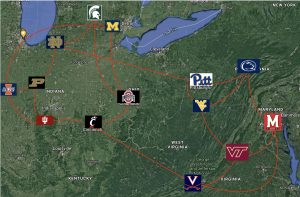
Big 14 Conference Rotation
The Big 14 in Other Sports
Ice Hockey
Nothing should change from the Big 10 to the Big 14 in Ice Hockey. Not unless the Heartland decides to sponsor Ice Hockey just for Minnesota and Wisconsin.
Men’s Tennis
I’m not sure the average Big 10 fan realizes the caliber of Virginia’s Tennis program. Virginia has won four of the last seven national titles and should be in contention for years to come. The only other members of the Big 14 with national titles are Illinois in 2003, Michigan in 1957, and Notre Dame in 1959.
Women’s Soccer
Penn State, Virginia, Notre Dame, and West Virginia have all played for a national title in the last ten years. Notre Dame winning it all in 2010 and Penn State in 2015. Virginia in particular should be relieved to get out from under the dominant power of North Carolina and into a conference where their program can flourish.
Men’s Soccer
Indiana, Virginia, and Maryland are some of the most consistent and competitive programs in men’s college soccer. They will all be battling for top-dog in the Big 14. Along with Notre Dame who won their first title as recently as 2013.
The PAC 14 Conference
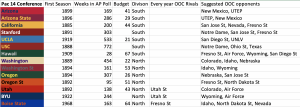
Changes to Note (From PAC 12)
Revenue Potential
The addition of Hawaii will bring in viewership from a new market. But that isn’t enough to solve the issues the PAC 12 has with generating revenue. The PAC 12 distributes the least amount of revenue to their member institutions of any of the power five conferences. To compound this issue, the conference already controls the entire West Coast. It is unlikely that adding a powerhouse program from farther east would increase interest in the conference.
What should increase interest and add revenue from the PAC 12 to the PAC 14 is that with a guaranteed spot in the playoffs (peek the proposed playoff structure below) the PAC 14 will be able to draw more interest from the college football fervent fans in the east. It should also ignite interest from PAC 14 fanbases. Who have felt left out or left behind by their exclusion from the current playoff system since 2014. Just as they were also left out of the BCS championship conversation for years.
Status Quo?
On the surface, there isn’t a lot of difference between the Pac 12 and the Pac 14. Hawaii, Boise State, and BYU are all solid additions, and the only loss was Colorado. The biggest difference is that the California schools will all be in one division instead of holding the cross-divisional play hostage.
Hawaii
Travel will always be an issue for Hawaii and all of its Home opponents. There is no way to get around that, but it shouldn’t keep a team with a significant commitment to its football program from competing with the best competition on the West Coast. Hopefully, with the increased income from joining the PAC 14, they will be able to improve their facilities and carry more weight in the plans for a new Stadium in Honolulu.
Boise State
It is understandable that the Pac 12 has been hesitant when it comes to the addition of Hawaii due to travel concerns. It makes no sense for Boise State not to been offered membership into the Pac 12. Instead, they have had to schedule teams like FSU, Oklahoma State, Virginia, etc. In order to play a more competitive schedule. The strangest part of adding Boise State is that in-state rival Idaho has more history with members of the Pac 12’s north division than Boise State does.
BYU
Conference rivalries with Utah and Boise State on an annual basis. As well as the stability of conference revenue that doesn’t come with being an independent. BYU will keep its annual rivalry game with Utah, and add annual matchups with the best teams on the West Coast.
PAC 14 Conference Divisions Mapped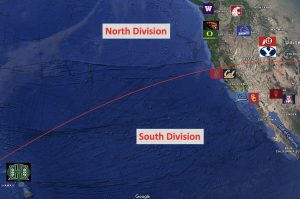
PAC 14 Conference Rotation
The PAC 14 in Other Sports
No Change?
Without much change to the conference, there will be little to no effect on sports other than football. The biggest changes will obviously be for Boise State, BYU, and Hawaii. BYU might be the most affected of the three as they currently compete in three different conferences and as an independent in order to accommodate each of their sponsored sports.
The Appalachian Conference

Changes to Note (From ACC)
Competition
Is this a watered-down version of the ACC? Yes. Is this also the only configuration that might actually draw interest out of the Northeast without having their teams dominated by far more accomplished teams in the fertile recruiting grounds of the South? Yes. The ACC has done a pitiful job of staying relevant in football north of South Carolina. So while they are in better financial standing than the PAC 12, their geographic position makes the dissolution of the conference inevitable. The ACC is well aware of this and is the reason for the astronomical buyouts that prevent its members from bailing off a sinking ship.
Louisville
Their main rivals will be played out-of-conference in Kentucky and Cincinnati. Yet they don’t really fit in culturally with the Big 14 or the SEC. I actually almost put them in the SEC, but they definitely have a greater opportunity to thrive in a more basketball oriented conference. Louisville really has an opportunity to establish a dominant presence in the South Division of the Appalachian Conference. If it can fight off its conference opponents in North Carolina.
Georgia State
This may look odd at first, but Georgia State is a program in its infancy. They have been able to gather a small but loyal fanbase in a short amount of time, and give the conference a stronghold in Atlanta. It will also be fun to see football games against strong opponents played on Turner Field. Georgia State will have the opportunity to show exponential growth in a relatively short amount of time.
Rutgers
Never belonged in the Big 10. They did more harm to their image by joining the Big 10 than they would have by joining a lesser conference. Getting stomped on as the Big 10’s doormat in a futile attempt at gaining more interest from the New York market was never a good idea. The money Rutgers gained in revenue from the Big 10 was mitigated by the lack of interest their fans had in playing teams like Iowa, Michigan State, and Indiana.
UConn
In the Big East, football was never a priority. Even in the first iteration of the conference. In the American, UConn basketball didn’t get to see the same level of competition it saw against it’s Big East opponents. In the Appalachian, both their football and basketball teams are in a great position to be competitive and find success within their conference.
Appalachian Conference Divisions Mapped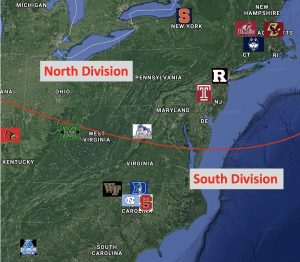
Appalachian Conference Rotation
The Appalachian in Other Sports
Men’s Basketball
I don’t mean to understate this, but the Appalachian would be the premier basketball conference in college athletics. Taking an already stacked ACC and adding UConn takes them over the top. Six of the programs in the Appalachian have won an NCAA tournament championship. Five of them have won it on multiple occasions (Sorry Syracuse). On the other side of this equation, Virginia will be missed. Not just because they won their first title last year. They will be missed because they have been a consistent program for decades. Having earned seven #1 seeds since 1982.
Men’s Soccer
UConn is a well-followed program in Men’s soccer. Who hasn’t found much success nationally in the last twenty years? In the Appalachian, they will find themselves up against North Carolina, Wake Forest, and Syracuse. Teams who have been able to find more recent success in the NCAA tournament in recent years.
The Western Conference

Composition
Nine members from the Mountain West Conference are joined by an independent in New Mexico State, a member of Conference USA, and three current FCS programs. Even though this conference spans from Southern California to North Dakota each of these teams have established rivalries, regional opponents, and a similar level of commitment to the long-term success of their programs.
New Mexico State
Someone might want to recheck this. But I’m pretty sure no other program has been spurned as much as New Mexico State by conference realignments. The Aggies have had four separate stints as independents and joined a conference on six separate occasions. In the Western Conference, they will have stability, historic rivalries, and competitive match-ups with teams across the Western US.
North Dakota State
NDSU has been such an incredible program for a long time. Not only have they won an incredible number of FCS championships, but have recently scheduled some major FBS opponents such as Oregon (canceled due to COVID, but the effort was there), Towson (in 2021 & 2023), Arizona (in 2022), and Colorado (in 2023). For a program that hasn’t needed to schedule Power five teams for large payouts, scheduling these types of games at this point seems like they might be in the feeling out process of a possible move to the FBS. The Western Conference would be the perfect landing spot for them. As they would easily be able to remain competitive and continue investing in their program.
Idaho
They left the FBS because they struggled to maintain interest from fans without a stable conference to affiliate themselves with. That would no longer be an issue with centralized governance overseeing college football. The Western Conference gives Idaho the ability to remain in one conference with teams of a similar size and level of competition
Northern Iowa
UNI is located in a growing area of a growing state. Located between Minneapolis and Chicago, moving to the FBS will give an already strong program the resources they need to expand their recruiting footprint. This move should give UNI the opportunity to have more success against their in-state counterparts in the Heartland Conference.
Western Conference Permanent Rivals Mapped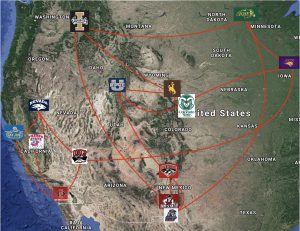
Western Conference Rotation
The Southern Conference

Why include the Western and Southern conferences in the FBS? Because the FBS needs mid-major programs. In the NFL, if a market is capable of supporting one or more teams, a franchise is able to move in to fill that market. College Athletics relies on programs being built up to meet the existing need in their area.
This is evidenced by the rise of programs throughout the state of Florida. The state quickly transformed from being the least populated state in the south to the third most populated in the country over the last 70 years. As the state has grown, programs have grown to fill the demand. First with the big three and now with programs like UCF, USF, FAU, and FIU.
Texas is another great example of a state that has seen massive population growth over the past 70 years. Unlike in Florida where the second wave of teams needed to be established, the population growth in Texas resulted in a number of programs seeing a major increase in available resources and interest. The continued growth and redistribution of population in this country make mid-major programs a necessity as a stepping stone for programs on the rise.
Southern Conference Permanent Rivals Mapped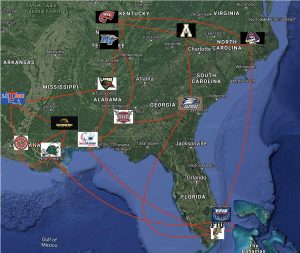
Southern Conference Rotation
The Military Academy Independents

The Military Academies are in a unique position as the only programs allowed to permanently remain independents. The only catch is that they must all play each other annually for the Commander-In-Chief Trophy.
Twenty Year Independents

This is an opportunity for FCS programs to join the FBS without having to immediately join a conference, and it is necessary for the same reasons including the Southern and Western Conferences was necessary. It gives programs the opportunity to grow their programs without clogging the FBS with smaller programs. They can instead join for a maximum of twenty years as an independent. Programs in this category would still be able to schedule FCS programs. However, it would be wise to play stiffer competition in order for a team to prove they belong in one of the eight FBS conferences.
At the end of their twenty years, if programs haven’t shown they are competitive enough to replace one of the member institutions in a conference geographically suited for them, they go back to the FCS. When a team is removed from a conference to make way for an independent, the removed team can either choose to stay in the FBS and start their twenty-year clock to try and rejoin a conference or move down to the FCS. If a team plays as an independent at the FBS level for twenty years and is unable to show that they are worthy of joining a conference, they must rejoin the FCS for at least fifteen years before they can try their hand in joining a conference as an FBS independent again.
Relegated to FCS
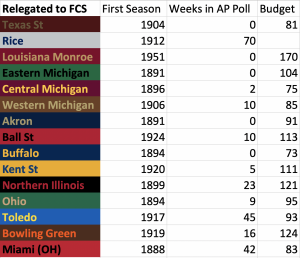
MAC
I relegated the entirety of the MAC, and no I don’t hate MAC football or the great lakes region. Support for these programs has been consistently declining as the population of the states in which they reside continues to decline. This is the other side of the equation when you talk about college football’s need for mid-major programs. As populations shift and mid-majors in growing areas of the country continue to rise up, programs like those in the MAC usually start to struggle.
The reason these programs are able to sustain themselves at the FBS level is that they operate bare-bones programs without regard for the wellbeing of their student-athletes or the on-field success of their programs. They schedule games without regard for what regularly playing mid-week games does to disrupt the academic schedules of their athletes throughout a semester.
When an athletic department is unconcerned with fan attendance or the sale of merchandise because they understand their sole revenue sources are inhumane scheduling and big-money games against major programs, it is time they reconsider their priorities. If any of these teams want to make the effort they still have the opportunity to come back as an independent. With the hope that they will be able to join either the Heartland Conference (most likely replacing an Arkansas State, Tulsa, Kansas, etc) or the Appalachian Conference (possibly replacing any one of the teams in the North division).
Texas State
The reason they were jumped over by the likes of North Texas and UTSA was simply that those other programs have much higher growth potential. However, if their athletic department felt differently and wanted to make the effort… They are geographically situated where they are capable of joining join the Southern, Western, or the SWC.
Rice
Once a great program, and at one time they were actually able to fill their whole stadium. It’s also been quite a while since that was the case, and Houston (the program) has since taken over as the best college team in Houston (the city). Rice has simply not shown the commitment or capability to staying competitive among the best programs in college football. If they wished to rejoin, they would be eligible to join the Southern or Southwestern Conferences.
Louisiana Monroe
It wasn’t a difficult decision to move down this team which has been around since the 1950s. It has never been in the AP, and who brings in less revenue than a lot of FCS programs as is.
Out of Conference Scheduling
Conferences should consist of historic rivalries, regional congruency, and consistent match-ups. However, teams don’t want to play the same teams every single year. They also want interesting, fun, and exciting match-ups that don’t come around very often. Below is the Out-of-Conference match-ups for 2020 adjusted for the new conference alignments and teams’ inability to schedule FCS opponents.

In addition to being unable to schedule FCS opponents, there are also fewer Mid-major programs to schedule. This leads to tougher schedules and fewer home games for almost every team. Since this list of match-ups is based on this year’s current schedule, there are some strange occurrences that would be unlikely to occur as the years progressed under the new conference alignment. For instance, Notre Dame only has five home games because they play @USC, @Navy, and Wisconsin in a neutral site game at Lambeau Field. Additionally, nearly every venue that had a neutral site game planned was scheduled to either have the same game or a game of similar stature.
What could a ten-game college football schedule look like with a twelve-team playoff?
![]()
![]()
![]()
Why would the regular season need to be cut short for there to be a twelve-team playoff?
With a ten-game schedule, the maximum number of games a team could play in a season would still be fifteen, as is currently the case. If you were to keep a twelve game schedule, there would be additional wear and tear on the student-athletes. You would also need to start the regular season a couple of weeks earlier. Which would mean playing in the brutal heat of summer. Or hold playoff games through the month of December. The later would leave college football competing with the NFL and NBA during the holiday season, and school winter break. The ten-game schedule avoids moral questions regarding the health of student-athletes. As well as the logistical questions of scheduling additional games.
The Ten Game Regular Season
Each conference would play the same eight-game conference schedule. Their non-conference slate gets cut down to two games. Yet they still have two bye weeks. For the majority of teams, this still leaves a lot of wiggle room to schedule some intriguing out-of-conference match-ups. Especially when they are still incapable of playing FCS opponents.

What would the Playoff look like?
The conference champions are guaranteed a spot in the playoffs. As well as the opportunity to host one playoff game on their home turf. The conference champions are ranked 1 – 8 with the top four getting a bye for the first round. The bottom four conference champions host a Round-one game against the top four non-conference champions. The winners of the first-round games are reranked 4 – 8. They then play on the road against those who received a bye. After Round-two the college football season continues as currently constructed. The round of four being played during the bowl season. The championship game being held on a Monday night early in January.
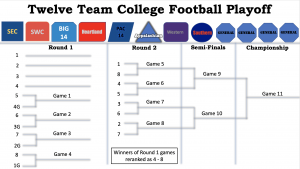
(This story was done as an independent study by Colin Guthrie and in no way reflects the views of ESPN Gainesville, WRUF or anyone associate with the University of Florida’s College of Journalism and Communications)
 ESPN 98.1 FM / 850 AM WRUF ESPN 98.1 FM / 850 AM WRUF
ESPN 98.1 FM / 850 AM WRUF ESPN 98.1 FM / 850 AM WRUF
